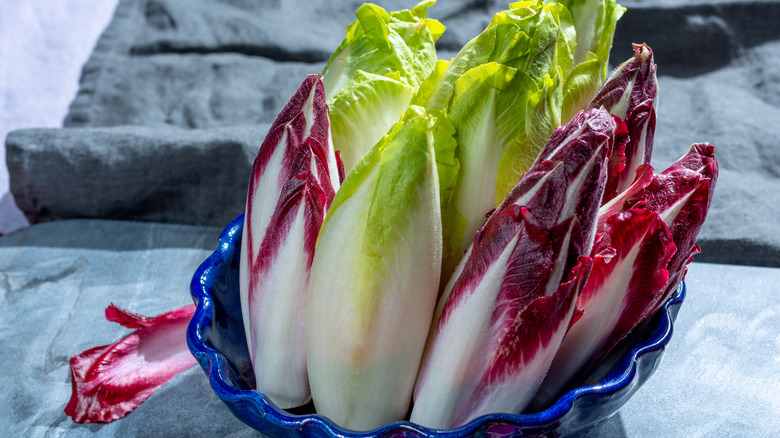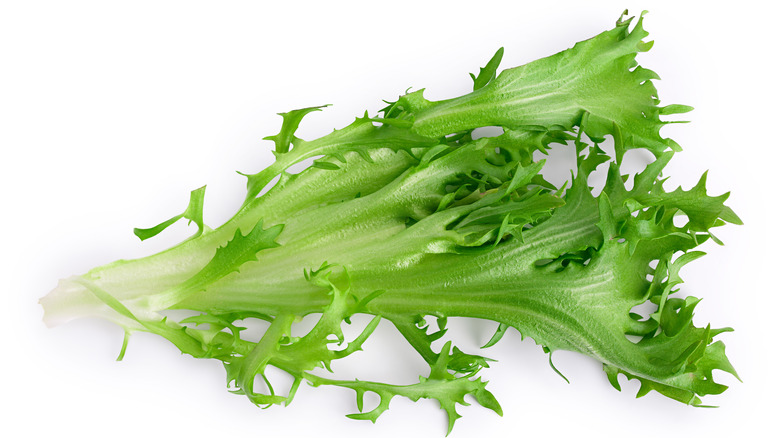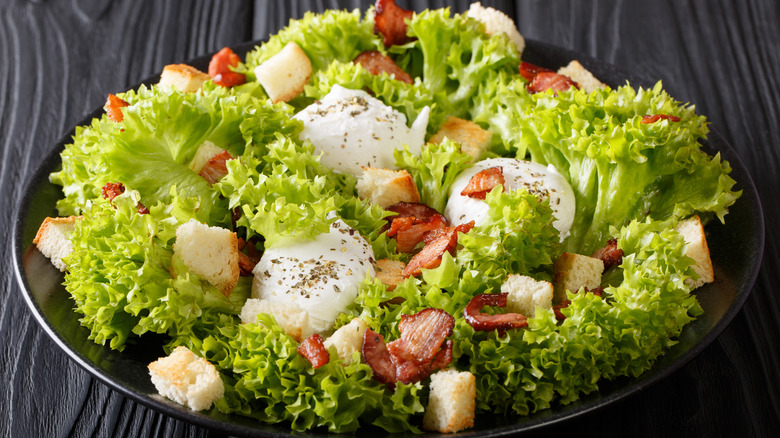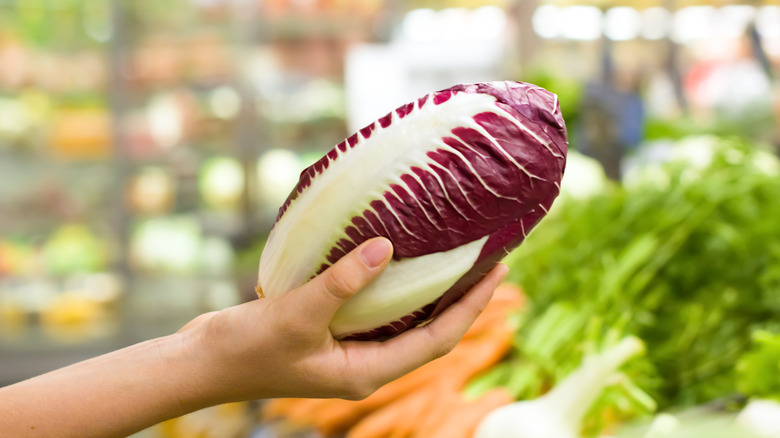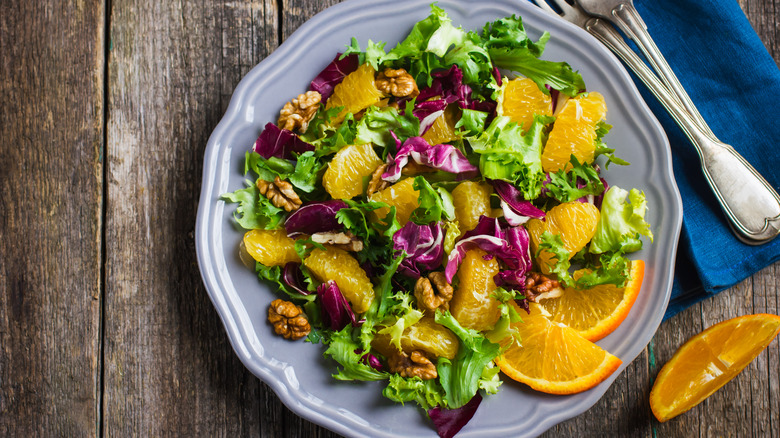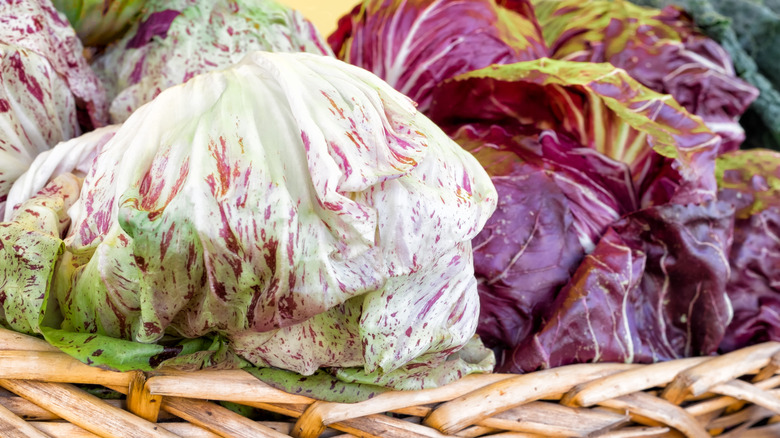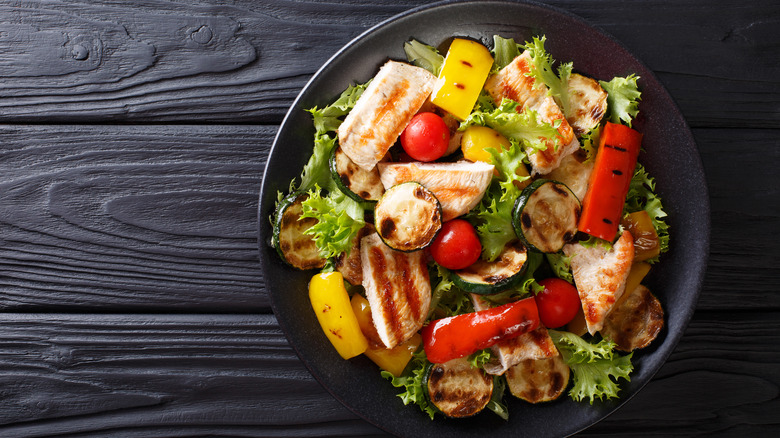What Is Chicory And How Do You Use It?
As you stand in the produce aisle, yearning for inspiration and, frankly, something to get you out of your broccoli rut, take note of the chicories. Yes, as in the plural of chicory, because there are many options that can easily invigorate tonight's dinner. Chicory (Cichorium intybus) is a blue-flowered perennial plant of the Asteraceae family, a clan that includes lettuce, daisies, sunflowers, chrysanthemums, asters, dandelions, goldenrod, coneflowers, thistles, artichokes, sunflowers, dahlias, marigolds, zinnias, asters, chamomile, sage, tarragon, ragweed, thistle, sagebrush, and yarrow (per PBS). The family of chicories includes Belgian endive, curly endive (aka frisée), escarole, and radicchio (via MasterClass).
Introduced to the U.S. in the late 19th century, chicory is native to Europe and is widely cultivated in the Netherlands, Belgium, France, and Germany. As a general rule, the leaves are eaten raw in salads, and the roots are cooked and eaten with butter (per Britannica). But rules are made to be broken and there are culinary applications for the chicories far beyond salads and simple buttery sides.
What is the taste and texture of chicory?
The Spruce Eats declares that chicories deliver a variety of tastes and textures for your dining pleasure because curly endive is thick and bushy, Belgian endive is soft and delicate, escarole is tender and wavy-edged, and radicchio is hearty and ruby red. The site adds that, when it comes to taste, chicories deliver a bitter earthiness, coupled with a subtle sweetness. Food & Wine adds that all chicory varieties are available year-round, and their bitter profile encourages us to balance flavors by adding acidity and sweetness. This playful combination of flavors makes chicories a welcome addition to the menu anytime, from fall and winter soups and braised and roasted dishes, to spring and summer salads, sandwiches, and stir-fries.
SFGate notes that the sweet, rich, mildly bitter chicory leaves mellow when grilled, steamed, and boiled, showcasing that there are plenty of ways to cook and enjoy these versatile greens. An Italian in My Kitchen agrees and states that the bitter, spicy flavor of chicories softens when cooked.
How do you cook with chicory?
Chicories can be eaten raw or cooked, which makes them an excellent addition to your produce arsenal. Chef Jake Nemmers of Flora Bar in NYC tells Bon Appetit magazine that sturdy chicories want "lots of salt and acid and fat; they're dying to be seasoned." For this reason, all chicory varieties partner well with strong flavors and textures, such as salty cheese, crunchy nuts, and sweet fruits — a medley that crafts one vibrant, robust salad. And because the leaves are hardy, a chicory salad won't lose its luster (or texture) as quickly as delicate lettuce leaves.
Note that some people find chicory greens overly bitter, so if that's the case for you, try blanching the leaves first (even for salads), and add a generous pinch of sugar or sweet balsamic vinegar to your recipes (via StackExchange). The Spruce Eats agrees and states that slow braising and/or roasting brings out chicory's sweetness and "tames the bitter edge."
To prep chicories for eating raw or cooked, Master Class suggests running the leaves under cool running water and patting them dry before using (discard any discolored or wilted leaves). To quell the bitterness, soak the leaves in cold water for 30 minutes before adding to raw salads or cooked dishes.
Where to buy chicory
Chicories are available year-round and can be found in the fresh produce section of the grocery store, often near the lettuces. Clean Eating magazine notes that chicories are often best when harvested in the late fall and winter because the shorter days expose the plants to less heat and light. That said, Harvest to Table asserts that chicories are hardy, cool-season perennials that can thrive in the spring and early summer in cold-winter regions, and in the fall and winter in warm-winter regions.
Fine Cooking magazine proclaims that winter is when chicories "really shine" because their color and texture reinvigorate mealtime. The magazine suggests illuminating your table with red radicchio, snow-white Belgian endive, and vibrant green frisée.
When shopping, choose chicories with firm, crisp leaves that are lively and hearty all the way to the leafy end. Avoid any chicories with wilted leaves and browning at the cut root end. When choosing varieties like endive and radicchio, the leaves should be tightly packed around the central core.
Is chicory nutritious?
Nutritionally, one cup of chopped chicory has 6.7 calories, 1.4 grams of carbohydrates, 0.5 grams of protein, and 1.2 grams of fiber, according to NutritionData, and chicory greens are a very good source of vitamins A, C, E, K, and B6, riboflavin, folate, pantothenic acid, calcium, iron, magnesium, phosphorus, potassium, copper and manganese.
Chicories are low in calories and rich in phytonutrients and antioxidants – powerful plant compounds, vitamins, and minerals that aid metabolism, boost immunity, maintain healthy skin, eyesight, bones, and the brain, prevent age-related macular degeneration, prevent certain cancers, and help reduce blood glucose and LDL (bad) cholesterol levels in diabetics (per Nutrition and You).
Health Benefits Times adds that chicory is an excellent source of dietary fiber, and the leaves contain probiotic compounds that promote a healthy digestive system and help prevent colon cancer. The leaves also contain powerful antibacterial properties that may help fight Staphylococcus aureus, Salmonella typhi bacteria, and Escherichia coli
What are the varieties of chicory?
Master Class explains that there are eight varieties of chicories, though not all will be available at your local market. Chioggia radicchio is the most common type of radicchio, and it resembles a small cabbage with magenta and white leaves. Treviso radicchio looks like chioggia radicchio, but the head boasts leaves that are longer and looser. Speckled radicchio is a commingling of radicchio and escarole, and the delicate leaves are freckled with magenta, green, and white.
Castelfranco radicchio consists of soft, creamy white leaves that are dotted with magenta flecks.
Belgian endive features small, oblong heads of tightly packed, firm, pale yellow and white leaves. Red Belgian endive is similar to regular Belgian endive, but the stiff, tightly packed leaves are magenta and white. Curly endive (frisée) is just as the name implies — a head of frizzy, light green and yellow leaves.
Escarole is a larger chicory variety, and the head of greens looks like Boston lettuce (aka butter lettuce).
Chicory inspiration for a dinnertime twist
For refreshingly unique chicory dishes, Food & Wine has a selection of recipes worth perusing, which include bitter green soup with cheese dumplings, Italian-style sautéed chicory with mustard greens, orecchiette with sausage and chicory, spaghetti with chicory and clams, and three unique salads — one with warm mushrooms, another with spiced pistachios, and one with pickled quince and pomegranate.
Olive Magazine shares some intensely creative dishes featuring the bitter greens, including chicory with lentils, beans, and breadcrumbs; chicory tart; pear, blue cheese, and chicory salad; roasted chicory slaw; creamy chicory risotto with walnuts; and spicy, orange-glazed chicory.
For something cheesy and comforting, BBC Food showcases an undeniably rich chicory gratin. If you cherish recipes with four ingredients or less, Epicurious offers a simple side dish of sautéed chicory with olive oil, garlic, and crushed red pepper flakes.
For a simple and unique side dish, Great British Chefs shares a recipe for golden brown, perfectly sweet chicory that's scented with soy sauce and orange juice.
